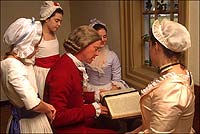Page content
The European Family

The family was the basic political, religious, social, and economic unit in early Virginia society and had both a private and public purpose. It educated the young and cared for the sick, disabled, and elderly. It was the first and most basic unit of government, but the ideals and customs varied among Africans, Europeans, and American Indians.
The Patriarchal Ideal
The traditional European family that immigrants brought with them was a patriarchy where the father was the supreme authority and ruled over wife, children, relatives, dependents, tenants, hired help, apprentices, servants, and slaves. Father was master of a rather inclusive family.
Patriarchy supported the dynasties that were the wealthy gentry and planters in Virginia. It helped to preserve the family lands through law and custom, and it built a ruling class through extensive and interwoven networks of kin that put wealth and political power into the hands of a few. For instance, the extended Blair family of Williamsburg produced leaders for the College of William and Mary, the Royal Governor’s Council, the Anglican Church, and local courts. The Blairs were kin with other equally influential families.
For small planters, artisans, and shopkeepers, a sense of family was built through work, and the children inherited a craft or business skill to make a living. Home and work were often in the same or adjacent buildings, so the inclusive family with servants, apprentices, and slaves was actually an economic unit of production rather than what we consider a family.
Each person might be part of several different families at one time or another.
A colonial Virginian might start with his or her parents, apprentice in another family, be a journeyman or maidservant in a third, then, more or less in order, establish a business, marry and start one’s own family, and finally be old and dependent in a child’s home.
Whether a family dynasty or a tradesman’s household, the patriarchal system was a miniature version of the British government ruling system where the king was the father of his people and the head of their national household.
The Patriarchal Reality
While the patriarchal theory depended on a male father figure, the patriarchal reality often had a woman as head of household. Colonial Williamsburg has examples of spinsters running their own businesses and widows taking over from deceased husbands, successfully running newspapers and taverns, among other businesses.
Society expected young white women and young widows to marry or remarry, but older widows often did not, and Williamsburg provided social support through friends and relatives and provided money through economic opportunity. Older widows assumed the role of the father figure in some families.
In contrast to modern times, there was no divorce among whites in colonial Virginia, so if a marriage was unhappy, the couple could ask the court for a separation, work out their differences, put up with them, or separate without a legal agreement.
For colonial children, the death or one of both parents was frequent. As early as the 1640s, the legislature passed laws for the care and education of orphans. Essentially, orphans with money got an education; orphans without money learned a trade. In either case, guardians and the church were responsible for the white population.
Content excerpted from the Colonial Williamsburg Foundation’s publication “Becoming Americans”.
